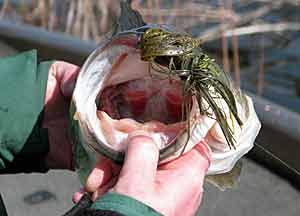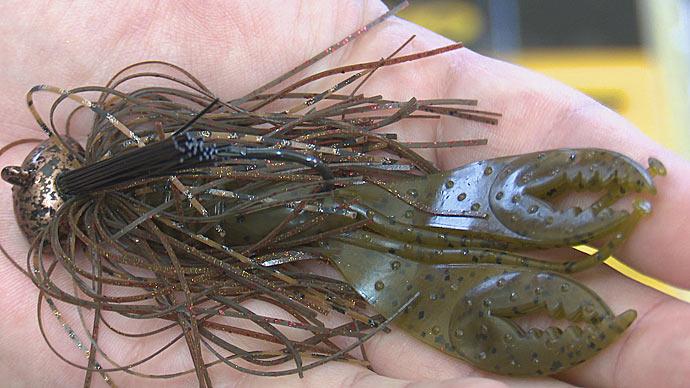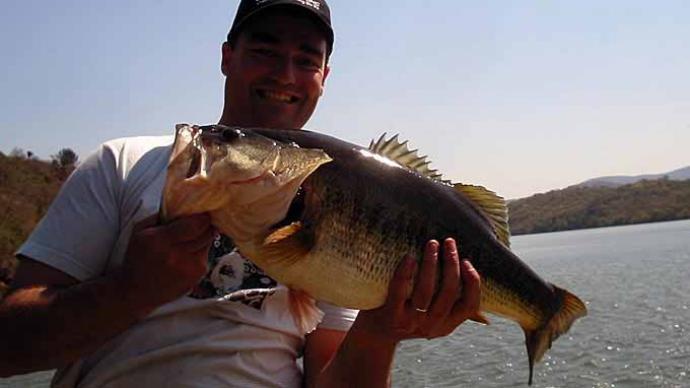
Right away, when anyone mentions jig and pig, you tend to automatically relate that with flipping and pitching to shallow, visible cover. And sure, that's a dynamite way to catch bass. But it leaves a giant window of opportunity open. Just as guys like David Fritts and Paul Elias exploit deep water with crankbaits, jigs can do the same.
Jigs, in my opinion, are more effective than crankbaits. First and most obviously, they are more weedless. Second, by using the weight of a sinking jig, you can more effectively present a bait to a deep strike zone. There's no waiting for a floating crankbait to reach maximum depth. You don't get worked to death like you do when deep cranking.
REMEMBER, DEEP IS A RELATIVE TERM TO WHERE YOU ARE FISHING! (6'or 20'or 50')
Jig As A Search Tool:
Like any other deep water fishing, the most critical aspects are bottom contour (structure) and the presence of cover and food (bait). This brings us to the first critical aspect of deep water jig fishing.
The jig is one of the best baits you can use to catch deep bass and figure out where they are located. A jig in deep water becomes both a fish catcher and a fish locator.
We have to clear up the myth that a jig is a slow presentation bait only. That's not true. Anyone who knows my fishing style knows that I'd rather fish fast and cover water. Well, that's what a big jig in deep water allows me to do. Using a heavy jig in conjunction with my electronics, I can find the type of areas that bass congregate around.
For example, I can find that one area of rock bottom along a mile stretch of channel drop. Or I can find that lone stump off the edge of a deep flat. Let's start at the beginning.
First, about seasonal pattern and water type, I start using my electronic eyes to locate the type of deep-water areas bass will be holding. Let's use the example of a deep, reasonably clear highland reservoir during the early summertime period; water temperature around the 70-degree mark.
Almost all bass are done spawning and well into their transition between spring spawning areas and deep summertime retreats. After identifying spawning areas (FLATS), I use my map to identify channels leading off flats to the main channel or main lake ledges(circle them in black pen). I then fast idle my boat across these circled areas. I'm specifically looking for the contour breaks and any distinctive features on these breaks. Seeing the presence of baitfish or cover on the bottom would enrich my chances.
Once I establish an area that meets the criteria I am looking for, I'll drop a marker buoy on the break or area that shows the most promise. It's now time to deploy the jig.
Using a heavy jig (1/2- to 1-ounce, 3/4 most often), I fan cast the potential area zig-zagging up and down in both directions. The jig becomes my bottom transmitter. I can tell the bottom compositions (mud, sand, rock, shell) and cover type (wood, weeds) by the feel. A graphite rod is a better deep-water transmitter than a fiberglass cranking rod.
Hopefully, this physical search with the jig will lead to something. If I find that I caught a bass every time I hit a hard rock area along with the break, my search can then be narrowed.
Jig As A Reaction Bait In Deep Water:
The second main strength is using a heavy jig as a reaction bait in deep water. Just as spoon fishermen use a heavy slab of metal to explore the depths, you can do the same with a jig.
This is an under-exploited technique. I first read about it after many tournaments on the West Coast were won doing this. On these deep, clear, western impoundments, guys took 3/4- and 1-ounce jigs and caught bass. What intrigued me was the fact that they were not finessing the fish. They were power-fishing and using the fast fall rate of the jig to trigger a reaction strike.
This is where a heavy jig will outshine a Carolina rig in deep water. The reaction is the key! You're not just trying to elicit a hunger strike here. This means you're now appealing to more bass. Yea, you're still going to catch the bass that is eating because their hungry. But now you're going to force inactive bass to hit. THAT'S THE KEY.
Inactive bass will strike at a jig whizzing by their head. (The human ball theory can be used here.) This technique is especially effective on more vertical break areas. I call it the crash and burn method.
I'll start by casting to the shallower lip areas, usually near the shore. I'll pop the jig up, letting it fall the stair-step break. Line watching is critical. Each time I pop it off the bottom, I let it fall back down on a semi slack line. You must often strip line under extreme deep break conditions.
This is also the technique I'll use when fishing around deep grass. In lakes where thick vegetation, such as hydrilla and milfoil, the grass often mats together, forming small tunnels in the grass. The heavyweight of the jig allows it to penetrate inside the mats and strands of grass and enters the tunnels. I'll use the same popping technique, but I will often only be able to get that first initial fall.
KEEP YOUR CAST SHORT. In deep water, you lose bait control when you make a long cast!
Lures:
I generally use Stone Jigs in weights ranging between 1/2-ounce and 3/4-ounce. I'll use the 1/2-ounce for depths between 10- and 30-feet and a 3/4-ounce for depths ranging from 30- to 50-feet. Deeper than 50, I'll go with a 1-ounce.
Color choice depends on both water clarity and forage. Generally, I like four colors: Natural and Green Pumpkin for clear water and where abundant crawfish are present; Black/Blue for stained water; and white where the primary forage is some shad or herring.
I use Uncle Josh Trailer depending on what the fish are telling me (action or straight tail). I also like to use Stone Jig Heads with just a spider grub body, especially ultra-clear water. I always use a glass Rattle!
Rod and Reel:
I use a 7-foot 3-inch medium-heavy rod with some tips. The rod is 7'3". It has enough length for good leverage and has enough tips.
The reel I use is both compact and palm fitting. It has a fast ratio to enable me to pick up the slack. It also has to have a great anti-reverse. It is a 6.3 to 1 gear ratio.
The line I use is heavily dependent on the conditions. Generally, I use clear fluorocarbon in 14- or 17-pound test for most applications. If cover permits, I might go green in a 12-pound test in extremely clear water.




